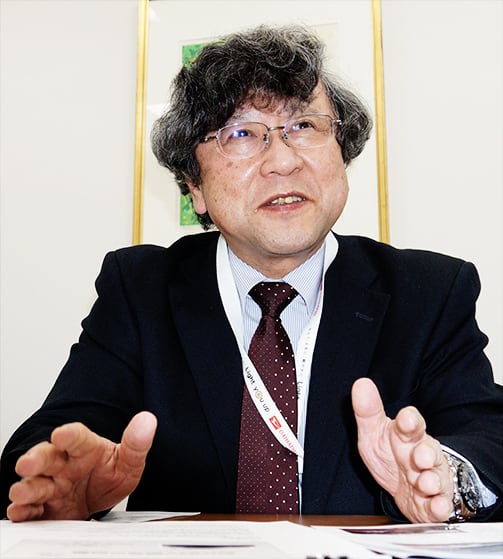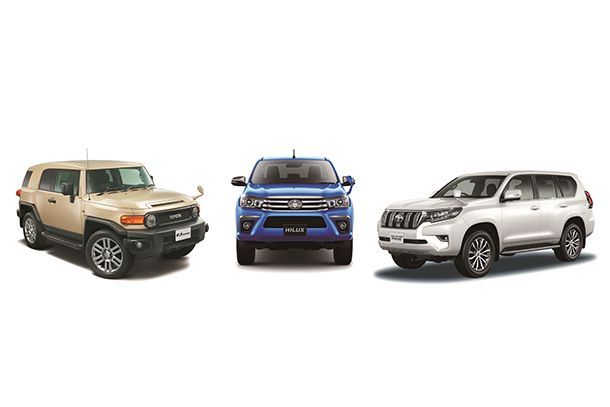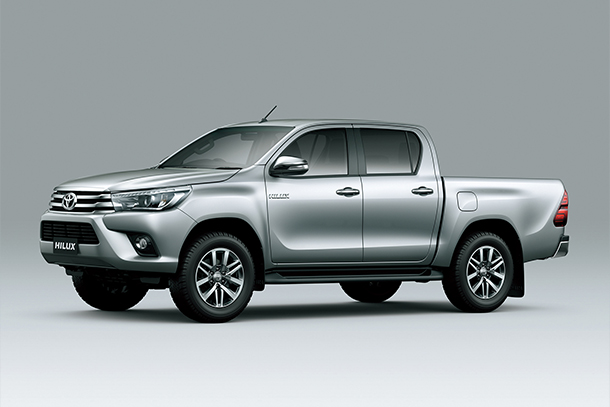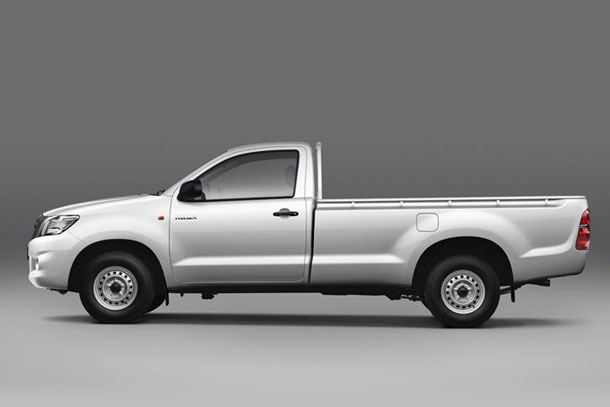May 25, 2018
Kaoru Hosokawa, Chief Engineer for the 7th generation Hilux
Realizing the Reliability of Made in Japan with Made by Toyota
The Hilux originated in Japan. Over a period of many years, it has been widely praised in North America, Australia and Thailand for its outstanding reliability, durability and off-road performance. In 1976, local production commenced in Indonesia and the Philippines on the TUV (Toyota Utility Vehicle), a pick-up truck with a load capacity of one ton. In Indonesia, this TUV was called the Kijang. Since 1990, a multi-person passenger variant of this pick-up truck has even acquired a reputation as the Indonesian national car.
Both the Hilux and Kijang featured body structures in which the body was mounted on a ladder frame; for this reason, even before the launch of the Innovative International Multipurpose Vehicle (IMV) project, there were numerous discussions regarding whether or not the platform of the two vehicles could be designed by common architecture. However, the Kijang―the Indonesian national car―was required to transport lots of luggage and people while maintaining low production costs. The Hilux, on the other hand, was aimed at European markets where regulations were more severe, and it was used not only for work but also as a passenger vehicle. For this reason, the Hilux required both a comfortable ride and a comfortable space―but this resulted in higher costs. During the discussion, those involved continuously struggled to find a way to integrate them, but in the end were unable to achieve a compromise. Following the Asian financial crisis around 1997-1998, Toyota gave serious consideration to how it could improve its overseas production businesses in the Asia region; the company was seeking a way to avoid exchange risk. Another look at the North American market revealed that pic-up trucks from the "Big Three"―such as Ford's F150―were being sold in their tens of thousands every month at extremely reasonable prices. They were even outselling passenger vehicles. Toyota therefore reached an idea to create reasonably priced vehicles in high volumes. By creating a standardized platform that was shared by both the Hilux and the Kijang, the company intended to realize merits of scale and offer locally produced vehicles to its customers at reasonable price. This, I believe, was the origin of the IMV project. Between 1998 and 2000, company executives tenaciously refined the concepts of the project. I was―and continue to be―indebted to the challenging spirit of my predecessors.
I was posted to the Product Planning Division in 1996, and in 2000. I was in charge of the development of Sequoia as part of the North American Project as a project general manager. In autumn of 2000, I was on a long-term business trip to the Indiana Plant in the U.S. to make preparations for start of production of Sequoia. One of my colleagues said to me: "It seems that discussions regarding the establishment of IMV have begun at Product Planning Division." He also informed me that the company appeared intent on creating a standardized platform for the Hilux and Kijang, developing multiple bodies at the same time, and producing them not in Japan but locally―in various countries in Asia, in South America, and in South Africa.
At that time, however, I was completely preoccupied with the launch of the Sequoia. Rumors of the IMV project entered one ear and exited the other. It didn't occur to me that I might one day be placed in charge of it. In the autumn of 2000, we managed to launch the Sequoia successfully. I was extremely relieved. Then, in 2001, I was placed in charge of a model targeted at emerging nations: this was the U-IMV project, the collaboration with Daihatsu on developing a compact minivan expected to be a brother of IMV minivan. I participated in this project as the Toyota representative for about a year and, together with Daihatsu, I was engaged with planning. In December 2001, we were just about to begin developing the styling of the model, when my superior said to me: "From next year you will be in charge of the IMV project."
I was overwhelmed. However, looking back now, I developed intuition and skills related to ladder-frame platform design while working on the Sequoia, and my participation in the U-IMV project enabled me to acquire experience of Indonesian and other emerging markets. This would prove to be of great benefit to me in the subsequent IMV product planning.
Promoting Visualization with a Multi-Dimensional Calendar
In January 2002, I had barely had enough time to study what the IMV project was, when I was enveloped by a massive wave of actual development. The first stage of the IMV project was to launch completely redesigned versions of the Hilux in Thailand and Kijang in Indonesia in August 2004: we had just two years and eight months. We were instructed to make acceptable proposals for the joint development of three Hilux pick-up models, the SUV Fortuner, and a minivan; we were also to make proposals for the vehicle designs, all before the end of the year. Fortunately, this was not all the sole responsibility of the new chief engineer.
As a matter of fact, since 1998 senior managing officers responsible for technology and sales had been having discussions regarding the IMV project, including key business aspects such as development, production, procurement, and sales. The goal of the team was to create a standardized platform for the Hilux and Kijang, simultaneously develop five body types, and produce them not in Japan but in Asia, South America, and South Africa. The aim was global production. Plants in five key countries would be fully ready for the mass production every six months or so and 100 percent of parts would be sourced locally. It is a project called the Innovative International Multipurpose Vehicle (IMV) project. Instead of a "Made in Japan" or "Made in Thailand" project, we aim to create something grand and innovative to supply to the world as "Made by Toyota."
The blueprints for this IMV project had already been drawn up by the latter half of 2000.
Even before my participation in the IMV project, the production engineering and manufacturing teams had been advancing preparations and considerations based on the IMV project blueprints. Each country had a schedule for its production preparations, and submission dates for the design drawings were decided accordingly. Based on the submissions dates for the design drawings the technological side had drawn up a detailed schedule, which included evaluations. In result the development side had an extremely strict schedule. Thanks to the blueprints, we didn't have to begin product planning from scratch―for an IMV beginner like me, this was a great help. From the beginning, those in charge of procurement, production engineering, manufacturing, and sales were able to unite and exchange concrete opinions.
The production engineering and development teams were involved in heated discussions on a daily basis. However, both our overseas affiliates and suppliers shared the lofty goals of the blueprints, which stipulated launching different models in different countries, and this was, I believe, a key reason why we were able to launch the models as scheduled in August 2004. At the beginning of 2000s, Toyota didn't have an overseas R&D organization. For Toyota engineers, this should have been extremely difficult work involving traveling to a large number of emerging nations; however, they were able to thoroughly understand the meaning of the blueprints, were extremely motivated, and focused on their designs. From my point of view, this was very encouraging.
When actual development started, and costs planning and the preparation for "copy mold" production were both critical elements of the IMV project. The preparation for "copy mold" entailed the careful creation of "Base molds" for Thailand and Indonesia, where they would be first completed. These would be copied for distribution to South Africa and Argentina. It was therefore crucial that the first molds were made with a high degree of precision as "Base Mold". The key was whether the design team would be able to keep to the schedule for finalizing the design drawings.
Cost planning also brought its own difficulties. When I worked on the Sequoia, we made estimation in Japanese yen and U.S. dollars. However, the IMV project required calculations to be made in more than ten currencies, including Thai baht, Indonesian rupee, Argentinian peso, and South African rand.
It was also necessary to create strategies to achieve rigorous cost targets before the development proposals were finalized. For each design team, the designers were given strategic schedules to cope with copy mold production and cost planning. With the help of the testing and production engineering teams, the design teams visualized to clarify what would be done by when. And, since there were multiple angles to consider―such as vehicle models, engine formats, grades, and production countries and so on―it was important to achieve a high level of visualization for each component.
Of course, this led to the creation of a complex calendar that incorporated a wide variety of elements―in other words, a multi-dimensional calendar. Besides the design team, the evaluation department also created such a calendar out of a desire to grasp how their work related to the bigger picture. In the design and testing areas, a number of boards were erected so that people could see at a glance how things were progressing, thereby enabling information to be shared among all relevant departments.
Due to the complexity of the IMV project, there were times when I was in danger of losing my way. But, the fact that the IMV team at all times visualized the progress of the project was, for me, a great help. We managed to create test vehicles in the latter half of 2002, and we subsequently carried out numerous driving tests: being able to drive the test vehicles was a clear sign that our work was steadily progressing towards the goal of 2004.
The Passion of TMT and the Decisions of its Leaders
In October 2003, there were just 10 months to go until the launch of the Hilux at Toyota Motor Thailand (TMT). This was a handover period from development to production and, accordingly, development had to be almost entirely completed by this time. In their efforts to verify whether development was close to completion, the engineering department came across a large number of unexpected problems. However, changing the design at this stage would have been extremely difficult.
A meeting to get approval on the start of pilot production had been planned for November, and we shared information regarding the latest development status with related parties in advance. One of our options was to delay the start of pilot production by a month. However, it seems that our intentions were somehow made known to TMT. Akio Toyoda was at that time chief officer of the Asia Operating Group, and he was concerned about the state of the preparations for IMV. He visited TMT and spoke to the top management and Key members people there. They said to him: "For such limited design changes, we would prefer things weren't delayed by a month. We will ensure that everything is accomplished, so let us proceed as planned. Everything will be ok." The all TMT members were proud to be an IMV production base, and their passion for the project was no doubt conveyed to Mr. Toyoda. At last the day came. At the meeting to get approval on the start of pilot production, I explained the status of progress, and I was about to communicate our desire to delay production by a month.
Chief Officer Toyoda said: "Please proceed as originally planned. If something happens, I will take responsibility for everything as the chief officer of the Asia Operating Group." And so the meeting concluded. I can still remember the events of November 2003.
It would have been ok if this had settled matters but, in actual fact, we faced another obstacle in January 2004, executives conducted an inspection of the entire IMV project. They identified more problems that would require further design changes. In January in Bangkok, in the extremely hot TMT plant building, I was covered in a cold sweat. Having elicited the support of the production engineering team, the manufacturing team and our suppliers, we decided to enlist the strength of the entire engineering division to resolve the situation. We had to incorporate countermeasures into a prototype vehicle and conduct durability tests at the Tahara Testing Annex. At that time, it was typical to drive 15,000 kilometers over the course of durability testing, and normally this would take in the region of one and a half to two months. However, in order to complete all our assignments without affecting the pilot production schedule, we only had a month in which to complete the durability tests. The evaluation team said to us: "We will be able to complete the tests in a month if you allow us to drive through the night." So, alternating drivers by day and by night, they completed the tests in a month. If any further problems had arisen at this point, I would have been in a truly desperate situation. Fortunately, however, our technical team managed to resolve all the issues by the end of April. Pilot production commenced according to schedule, with a view to beginning sales in August.
I breathed a deep sigh of relief. Everything worked out in the end, and TMT launched the Hilux in August as originally planned.
As it turned out, however, this was not the end of our development story.
No Time to Catch our Breaths: Aiming for Even Better Performance
Sales commenced in Thailand and Indonesia in August 2004, with exports to Europe, Australia, the Middle East, and other countries scheduled to begin the following year. This meant we had just twelve months to carry out development work that had a high degree of difficulty. For example, operating temperatures for cars in Thailand would peak at about 35˚C; in the Middle East, however, peak temperatures would be around 45˚C. In addition, driving through deserts would increase the load on the engine, creating difficult conditions for the cooling system. Engines destined for Europe, meanwhile, were required to comply with Euro4 grade of exhaust emission regulation stricter than that of Thai, Euro3 grade. It meant that there were still many hurdles to overcome in August and beyond. We had no time to catch our breaths.
The Hilux was in its seventh-generation, and we sought to carefully utilize the technological knowhow that had been acquired during the development of previous iterations of the vehicle: our aim was to create an even better Hilux. With regard to the engines, we launched new grades that featured the same engines as used in the Land Cruiser Prado and 70 series. But when we did this, our customers came to us with new demands. I flattered myself in believing that I had created a Hilux with superior performance to the previous generation model; however, our customers were comparing the new model not to the old Hilux, but to the Land Cruiser. As a vehicle put to work in the mines, for example, it was being compared to the Land Cruiser 70 pick-up. It goes without saying that the ride comfort of the Hilux was preferable; however, a lack of durability became apparent after extended use over rough terrain.
Even after launching the vehicles in 2004, the engineers and I learned a great deal from the market.
Although the new Hilux was designed to meet strict internal standards, it was a fact that some parts of previous generations of Hilux exceeded these standards by a long way when it came to durability. It was not over quality design. For this reason, we were in danger of betraying the expectations of customers who had driven successive iterations of the vehicle. While developing the new Hilux, we believed we had made careful use of the knowhow accumulated over many generations; instead, however, we experienced just how difficult it was to grasp what had changed and what had remained constant in terms of market demands. Furthermore, in Japan, there was a strong sense of Hilux as a commercial vehicle, so manual air-conditioning is the expectation, but users in other regions implored for automatic air-conditioning and power windows, because it is used as a passenger vehicle locally. Such requests were initially difficult to comprehend. It is easy to create a high-quality car if cost is of no consequence; and yet such conditions rarely exist. Again and again, we negotiated with the design team for cheaper designs and with the sales team for reasonable price worth to the value. In the end, we came to the realization that it was extremely important to understand the market and our customers' market outlooks when engaging in product planning. In an effort to understand our markets, we went to various countries where the vehicles were to be sold and exchanged opinions with locals there. However, it took many, many years before we were able to say with confidence that we understood the unique market preferences of the different sales region.
Increasing the Size to Allow Users to Transport People and Cargo More Easily
There were no plans to sell the seventh-generation Hilux in Japan. For this reason, when proceeding product planning there was no need to adhere to Japanese vehicle regulations. Taking an example of body size, we were relieved from the restraint of maximum width of 1,700 mm. We considered the comfort of the interior from an ergonomic standpoint, and the sales, design and testing teams discussed and decided on the design together. However, we were unsure how to approach the deck size, since cargo cannot speak for itself.
We therefore consulted with TMT, and they informed us that the size of the baskets used to transport fruit was regulated. They proposed deciding how many baskets we wanted customers to be able to load, and adjusting the deck size accordingly. Thinking this to be a good proposal, we designed a deck that would allow more baskets to be loaded than rival models. Now that we had decided on the cabin and deck, the size of the body more or less took care of itself. However, we wanted to realize smaller turning radius of the vehicle and, for this reason, we began discussing how we might shorten the wheelbase by a matter of millimeters. When determining the turning radius of the vehicle, TMT technical members were of great help: by attaching urethane rubber at the both corners of front bumpers onto a sixth-generation Hilux, they created a mock-up that had the same vehicle width as that proposed for the seventh-generation Hilux. They tested this mock-up in various situations around urban Bangkok: they drove it in traffic jams, through narrow roads, they parked it, and confirmed how narrow it would need to be to be usable for our Thai customers. They even checked the convenience of the mock-up at Bangkok's morning markets, where large numbers of pick-up trucks gather. Thanks to these simple and straightforward preparations, the seventh-generation Hilux has been widely praised by customers for its optimized body size. In the end, the seventh-generation Hilux was widened by 60 mm compared to the previous model; however, improvements to the steering system meant that its minimum turning radius was decreased by 0.2 m from the sixth generation.
A little while after the launch of the Hilux, however, new issues were raised in various countries. In Thailand, many customers used the Hilux with their families as a passenger car. In Australia, however, the Hilux was used in some cases by professionals such as park rangers; they drove the vehicle on a daily basis on roads so bad they resembled off-road test courses. It is extremely difficult to cater to both Thai and Australian usage scenarios with a single design and set of specifications. In addition, Australian customers indicated that the towing capacity of the Hilux was insufficient. We had retained the same towing capacity of the previous model but, since the new Hilux had greater engine power and torque, customers were hoping for greater towing capacity as well. In Thailand, there is no culture of towing. To be honest, it seems we underestimated the Australian market. In 2011, we partially redesigned the Hilux, incorporating as many of the requests from customers across the world as possible. This was the second of two, significant minor change―the first had been carried out in 2008. The introduction of the Access door version for C-cab exclusively for Thai was that timing. This was the first big work of young engineers of TMAP-EM. Great Job was it. I believe that we were able to implement everything we had learned from markets since the vehicle's launch in 2004, including improvements to the vehicle's design and driving performance. We were extremely confident in the redesigned Hilux. However, we were not able to instill in the Hilux the toughness demanded by professional customers from Australia and other southern hemisphere countries. This was something we would have to entrust to the eighth-generation model.
Further Evolution of Hilux
Hilux has utilized a ladder frame since its inception. On the other hand, cars have for a long time now typically used monocoque bodies. Vehicles are supposed to be made lighter with monocoque constructions, and so in recent years there has even been an argument for trucks to be made in this way, due to improved fuel efficiency and environmental performance. However, for a vehicle like the Hilux, which is intended to be driven on unpaved roads on a daily basis, even a monocoque body would have to be suitably heavy in order to guarantee the required durability and reliability.
But what, exactly, is a ladder frame construction?
In the event of a collision, a ladder frame absorbs the energy of the collision through deforming―such as by collapsing or bending; meanwhile, impacts from the road are smoothly absorbed by the suspension and, so long as the frame to which the suspension is attached is sufficiently rigid, the tires and suspension cater to the unevenness of the road surface. In this way, a ladder frame construction lays a foundation so that the suspension can work effectively .The rear leaf springs act as shock absorbers for vertical motion. However, the design of the Hilux leaf springs mean that each leaf imparts resistance via friction; in addition, by twisting in a three-dimensional manner, they enable the left and right tires to stay in contact with the road surface for as long as possible, even on rough, uneven terrain. In other words, the leaf springs function as more than just vertical shock absorbers. The rear suspension utilizes simple and old fashioned looking leaf springs, but it incorporates Toyota's knowledge of off-road performance.
I believe that ladder frames and leaf springs still have plenty of room for improvement, not only in their reliability and durability, but also in their driving performance and quietness. I hope that future iterations of the Hilux will take the toughness of the eighth-generation model, further refine it, and increase its popularity worldwide.
Finally, What Does IMV Mean to Me?
At least until the launch of the Hilux in Thailand and Indonesia in 2004―which comprised the first stage of the IMV project―I strongly believe that I relied on the help of a great many people. This is not particularly becoming for a chief engineer.
After the launch of the Hilux, the IMV project was regarded as a success and met with widespread praise. This was in part due to the cohesion of the entire Toyota Group, and it was in part due to the fact that, for three years before I began participating in the project, blueprints had been carefully drawn up. The blueprints specified that the platforms for the Hilux and Kijang would be standardized, the models would be developed at the same time, and that they would be launched at the same time; and they carefully delineated the business aspects of procurement, production and sales. These were the keys to the success of the IMV project. I was responsible for developing a new vehicle―but this was just one aspect of the vast IMV project.
I feel that I was able to operate in a manner appropriate to a chief engineer only between 2004 and the summer of 2011, when I handed over my responsibilities to Mr. Nakajima. Throughout this period, IMV models were able to maintain growth in sales. We experienced momentary setbacks such as the Global Financial Crisis of 2007-2008 and the Thailand floods at 2011; overall, however, it was a positive and stable period, both in terms of the global economy and the political situation across the world. I was fortunate to be working under an extremely favorable set of circumstances. And, I was able to make many friends across the world. The things I have experienced through this job are irreplaceable.
- CE for 7th generation Hilux
- Kaoru Hosokawa
- Apr. 1979
- Joined Toyota Motor Company
- Jan. 1999
- Chief Engineer, Toyota Vehicle Development Center 3 (1st generation Sequoia)
- Mar. 2001
- Chief Engineer, Toyota Vehicle Development Center 3 (joined U-IMV project with Daihatsu)
- Jan. 2002
- Chief Engineer, Toyota Vehicle Development Center 3
- Sep. 2011
- General Manager, Product Planning Group.
- Apr. 2012
- Transfer to Sumitomo Rubber Industries Ltd. (Dunlop Tire)
- Mar. 2014
- Retire Toyota Motor Corporation at age 60
- May 2016
- Joined Daihatsu Motor Corporation as a Technical Advisor











